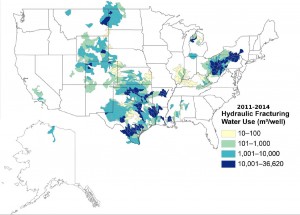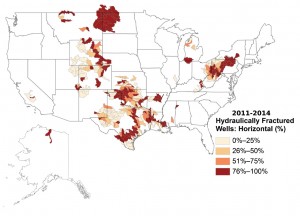Study includes first nationwide map of water usage for hydraulic fracturing
30 June 2015
WASHINGTON, D.C. – The amount of water required to hydraulically fracture oil and gas wells varies widely across the country, according to the first national-scale analysis and map of hydraulic fracturing water usage detailed in a new study accepted for publication in Water Resources Research, a journal of the American Geophysical Union. The research found that water volumes for hydraulic fracturing averaged within watersheds across the United States range from as little as roughly 9,800 liters (2,600 gallons) to as much as 37 million liters (9.7 million gallons) per well.

Average water volumes used to hydraulically fracture oil
and gas wells (horizontal, directional, and vertical) drilled from January 2011 through August
2014.
Credit: Tanya Gallegos
In addition, from 2000 to 2014, median annual water volume estimates for hydraulic fracturing in horizontal wells had increased from about 670,000 liters (177,000 gallons) per oil and gas well to more than 15 million liters (4 million gallons) per oil well and 19 million liters (5.1 million gallons) per gas well. Meanwhile, median water use in vertical and directional wells remained below roughly 2.5 million liters (671,000 gallons) per well. For comparison, an Olympic-sized swimming pool holds about 660,000 gallons.
“One of the most important things we found was that the amount of water used per well varies quite a bit, even within a single oil and gas basin,” said Tanya Gallegos, a scientist at the U.S. Geological Survey in Virginia, and the study’s lead author. “This is important for land and resource managers, because a better understanding of the volumes of water injected for hydraulic fracturing could be a key to understanding the potential for some environmental impacts.”
Horizontal wells are those that are first drilled vertically or directionally (at an angle from straight down) to reach the unconventional oil or gas reservoir and then laterally along the oil or gas-bearing rock layers. This is done to increase the contact area with the reservoir rock and stimulate greater oil or gas production than could be achieved through vertical wells alone, according to the study’s authors.
However, horizontal wells also generally require more water than vertical or directional wells. In fact, in 52 out of the 57 watersheds with the highest average water use for hydraulic fracturing, over 90 percent of the wells were horizontally drilled, according to the new study.

Percent of hydraulically fractured wells that were horizontally drilled from January 2011 through August 2014 in watersheds in the United States (n=47,646).
Credit: Tanya Gallegos
Although there has been an increase in the number of horizontal wells drilled since 2008, about 42 percent of new hydraulically fractured oil and gas wells completed in 2014 were still either vertical or directional. The ubiquity of the lower-water-use vertical and directional wells explains, in part, why the amount of water used per well is so variable across the United States, according to the study’s authors.
The watersheds where the most water was used to hydraulically fracture wells on average coincided with parts of the following shale formations:
- Eagle Ford (within watersheds located mainly in Texas)
- Haynesville-Bossier (within watersheds located mainly in Texas & Louisiana)
- Barnett (within watersheds located mainly in Texas)
- Fayetteville (within watersheds located in Arkansas)
- Woodford (within watersheds located mainly in Oklahoma)
- Tuscaloosa (within watersheds located in Louisiana & Mississippi)
- Marcellus & Utica (within watersheds located in parts of Ohio, Pennsylvania, West Virginia and within watersheds extending into southern New York)
Shale gas reservoirs are often hydraulically fractured using slick water, a fluid type that requires a lot of water. In contrast, tight oil formations like the Bakken (in parts of Montana and North Dakota) often use gel-based hydraulic fracturing treatment fluids, which generally contain lower amounts of water, according to the study’s authors.
This research was carried out as part of a larger effort by the USGS to understand the resource requirements and potential environmental impacts of unconventional oil and gas development, the study’s authors said. Prior publications include historical trends in the use of hydraulic fracturing from 1947-2010, as well as the chemistry of produced waters from hydraulically fractured wells, the authors said.
###
The American Geophysical Union is dedicated to advancing the Earth and space sciences for the benefit of humanity through its scholarly publications, conferences, and outreach programs. AGU is a not-for-profit, professional, scientific organization representing more than 60,000 members in 139 countries. Join the conversation on Facebook, Twitter, YouTube, and our other social media channels.
More information about this study and other USGS energy research can be found at the USGS Energy Resources Program.
Journalists and public information officers (PIOs) of educational and scientific institutions who have registered with AGU can download a PDF copy of the article by clicking on this link: http://onlinelibrary.wiley.com/doi/10.1002/2015WR017278/abstract ?campaign=wlytk-41855.5282060185
Or, you may order a copy of the final paper by emailing your request to Leigh Cooper at [email protected]. Please provide your name, the name of your publication, and your phone number.
Neither the papers nor this press release is under embargo.
“Hydraulic fracturing water use variability in the United States and potential environmental implications”
Authors:
J. Gallegos: U.S. Geological Survey, Eastern Energy Resources Science Center, Reston, Virginia, U.S.A.;
B.A. Varela: U.S. Geological Survey, Central Energy Resources Science Center, Denver, Colorado, U.S.A.;
S.S. Haines: U.S. Geological Survey, Central Energy Resources Science Center, Denver, Colorado, U.S.A.;
M.A. Engle: U.S. Geological Survey, Eastern Energy Resources Science Center, Reston, Virginia, U.S.A.; and University of Texas at El Paso Department of Geological Sciences, El Paso, Texas, U.S.A.
Contact Information for Authors:
Tanya Gallegos: +1 (703) 648-6181, [email protected]
Leigh Cooper
+1 (202) 777-7324
[email protected]
U.S. Geological Survey Contact:
Anne Berry Wade
+1 (703) 648-4483
[email protected]